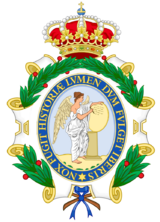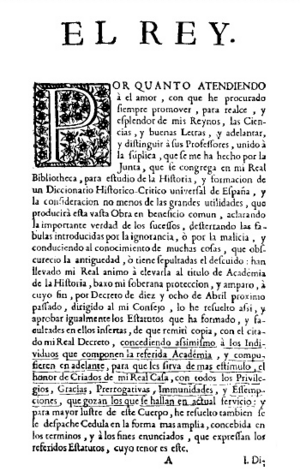Royal Academy of History facts for kids
|
Real Academia de la Historia
|
|

Arms of the Royal Academy of History
|
|
| Abbreviation | RAH |
|---|---|
| Formation | 18 April 1738 |
| Founder | Felipe V |
| Purpose | To study the history of Spain and its people |
| Headquarters | Madrid, Spain |
|
Region served
|
Spain |
|
Official language
|
Spanish |
|
Protector
|
Felipe VI (as King of Spain) |
|
Director
|
Carmen Iglesias |
|
Main organ
|
Governing Board |
|
Parent organization
|
Institute of Spain |
| Affiliations | Union Académique Internationale |
The Royal Academy of History (Spanish: Real Academia de la Historia, RAH) is an important Spanish group in Madrid. Its main job is to study all kinds of history about Spain and its people. This includes their culture, politics, and daily life, from ancient times to today. The academy was started by King Philip V of Spain on April 18, 1738. Its official magazine is called the Boletín de la Real Academia de la Historia.
Contents
The Academy's Building
Since 1836, the academy has been in an old building. A famous architect named Juan de Villanueva designed it in the 1700s. This building was first used by a religious group called the Hieronymites. It became available after new laws in the 1830s changed who owned church properties.
Historical Collections
The Royal Academy of History used to be the main place in Spain for studying old things. Because of this, it has many important old books and collections of ancient items. These collections are not open for the public to see. The person in charge of these old items is a prehistorian named Martín Almagro Gorbea.
Some of the special items they keep include:
- The Glosas Emilianenses: These are very old notes written in the margins of a Latin book. They are important because they show early examples of the Spanish language.
- The Códice de Roda: This is an old book from the 900s. It contains important historical records.
- The San Millán Beatus: This is a beautifully illustrated manuscript from the Middle Ages.
- The Missorium of Theodosius I: This is a large, fancy silver dish. It was likely made in Constantinople around 388 AD. It celebrated ten years of Emperor Theodosius I's rule. This dish is a great example of ancient Roman art and metalwork.
Biographical Dictionary Project
The academy worked on a huge project called the Diccionario Biográfico Español. This is a dictionary of Spanish national biography. It's like a giant encyclopedia about important people from Spain's history. About five thousand historians helped write it.
The first 20 books of this dictionary came out in 2011. This project was paid for by the public. However, some people felt it wasn't always fair or objective. For example, some thought it was a mistake to include living people in the dictionary. There were also concerns about how it described people from the time of Francoist Spain.
A well-known example was the entry for Francisco Franco. He was a leader in Spain. The dictionary described him as an "autocratic head of state" instead of a "dictator." This caused a lot of debate. Many people, especially from left-leaning groups, were upset. They asked for changes to be made.
In 2011, the academy said they would make changes to the online version and future printed books. By 2015, the director, Carmen Iglesias, promised to update the online text. In 2018, the online version, called Diccionario Biografico Electronico, was launched. In this updated version, Franco's role as a dictator was confirmed.
Working with the Metro
In 2015, the academy started a project with Madrid Metro. This project aimed to share information about people who have Madrid Metro stations named after them. For example, stations like Concha Espina and Paco de Lucia are named after famous people. Display panels were put in these stations to tell passengers about these individuals.
Protecting Historical Monuments
In 2020, during the George Floyd protests, some statues of historical figures were damaged. This included statues of Christopher Columbus. The academy released a statement saying they were sad about these attacks. They also said they are dedicated to truly understanding Spain's history in America. They want to make sure this history is not twisted or used for political reasons.
Members of the Academy
The Royal Academy of History has different types of members. According to its rules, there can be up to 36 "numbered academics." These members must be Spanish citizens. There are also "academics of honour" and "academic correspondents." These members can be from any country. Carmen Iglesias has been the director of the academy since 2014.
The current Numbered Academics are listed below by their chair number:
- Vicente Pérez Moreda
- Hugo O'Donnell y Duque de Estrada
- Vacant
- Vacant
- Feliciano Barrios Pintado
- José Manuel Nieto
- Josefina Gómez Mendoza
- José Remesal Rodríguez
- María del Pilar León-Castro Alonso
- Octavio Ruiz-Manjón
- Martín Almagro Gorbea
- Elena E. Rodríguez Díaz
- Jaime Salazar y Acha
- Francisco Javier Puerto Sarmiento
- Juan Pablo Fusi Aizpurúa
- Antonio Cañizares Llovera
- Amparo Alba Cecilia
- José Antonio Escudero López
- Luis Antonio Ribot García
- Vacant
- José Ángel Sesma Muñoz
- Enriqueta Vila Vilar
- María del Carmen Iglesias Cano
- Fernando Marías Franco
- Miguel Ángel Ladero Quesada
- Serafín Fanjul García
- Miguel Ángel Ochoa Brun
- Luis Alberto de Cuenca y Prado
- José Luis Díez García
- Carmen Sanz Ayán
- Enrique Moradiellos García
- Carlos Martínez Shaw
- María Jesús Viguera Molins
- Juan Francisco Fuentes Aragonés
- Xavier Gil Puyol
- Luis Agustín García Moreno
See also
 In Spanish: Real Academia de la Historia para niños
In Spanish: Real Academia de la Historia para niños


